1905
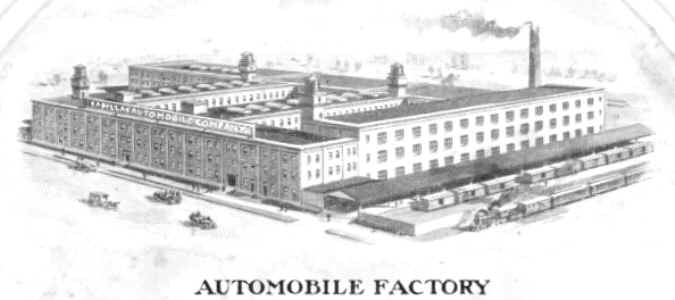
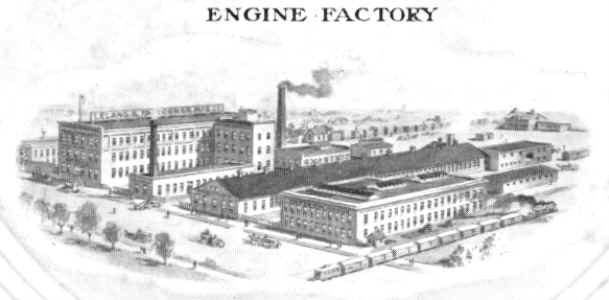
Facts: 1905 models
were introduced in December, 1904. First appearance of Cadillac script on radiator (it was
sometimes added by subsequent owners to earlier models), and Cadillac coat of arms
(registered 1906), all 1-cylinder models had 9HP motor (rated 8½ to 10 HP); modified
support of friction bands on planetary gears; first 4-cylinder Cadillac introduced;
pressed steel frame, 7-gallons gas, 3-gallons water (coolant). Consolidation in late 1904
of Leland & Faulconer with Detroit Automobile Co. as new Cadillac
Motor Car Co.; Leland takes over as General Manager. Article in AU 12.31.1904,
pp.756/7.
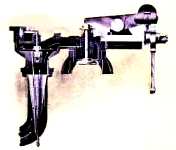 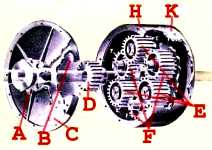
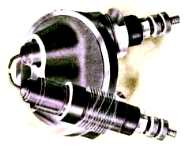
Left: 1905 Cadillac carburetor, center: transmission,
right: spark plug
Easy ID: Model B:
(no change). Model C carries Model B body on Model B
chassis [with I-beam front axle], but features the new, Model E hood; color:
Brewster green with primrose running gear. Model E with new hood featuring ten
vertical side louvers, tubular, curved front axle, color: same as Model C. Model
D: longer hood, needed to house new, 4-cylinder engine; front of headlamps almost
level with front spring shackles.
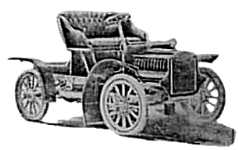 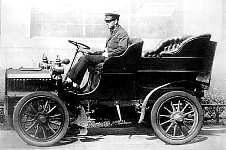
Model C runabout (left) and touring car
(right)
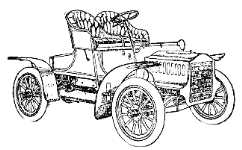 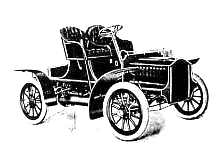
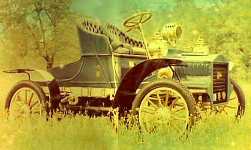
Model E runabout (in color: a survivor)
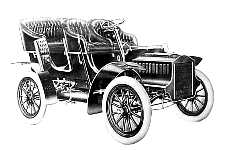 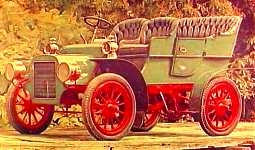
Model F touring car (a survivor, on the
right)
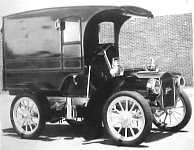
Model F delivery wagon
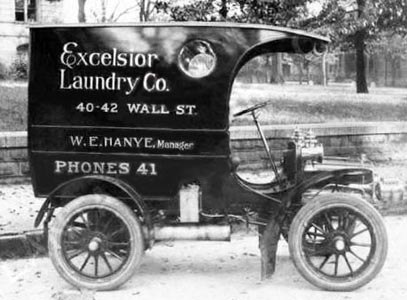
1903 Model A delivery wagon (round window glass) on u
pdated 1905-08 Cadillac chassis (hood, rear fenders)
Models: (1) Model
B 4-passenger tourer, $900, 1450 lbs, (2) Model B 4-passenger Surrey,
$900, 1450 lbs, (3) Model B rear entrance Touring car [no change from
previous year]; like Model F touring car except weight approximately 1450 lbs (AU
reported weight at 1350 lbs as against 1450 for Model B Surrey and 1100 lbs for Model
E), over-all width 5'5" (165.1cms), over-all height 5' (152.4cms), $900 FOB
Detroit; optional color: maroon; arched, tubular front axles, center strut and truss rod
below; top of arch attached to flat, transverse front spring; 61" tread optional
(154.94cms), dummy hood, removable tonneau, like 1904 model, $900; standard color Brewster
green (maroon optional); lamps still optional. (3) Model C runabout, $750,
1330 lbs [photo in 1928 GM ad]; like last year's Model B but with pressed steel,
I-beam front axle; small photo, CLCA 1978, p.12; (4) Model C tourer
for 4-passengers, $850, 1450 lbs; (5) Model E runabout for 2-passengers,
$750, 1100 lbs, like Model B but different dummy hood with radiator featuring
zigzag tubes and closely set square fins; tread 56½" (143.51cms), wheels 28"
(71.12cms) [all others are 30"), 74" wheel base (187.96cms), 3" Dunlop
tires (7.62cms) (other tire makes optional ), individual seats trimmed in hand-buffed
black leather, color Brewster green with primrose running gear, 10-41 gear (optionally
10-31 or 10-38), top irons $5 extra; $750, louvered hood; no tonneau option (not
convertible), rubber top $30, leather top $50, optional top and lights, 74" wheel
base (187,96cm), arched, tubular front axle [as above]; (6) Model E
Runabout with top, as above but 10-38 gear (optionally 10-34 or 10-41), $800 with complete
leather top, sides and storm apron, $780 with rubber top, sides and storm apron; B&W
advertisement in book of Cadillac ads, 1902-1961, p.7.; buggy top also available. (7)
Model F, 2-door, 4-passenger Touring car, $950, 1350 lbs, standard color Brewster
green with primrose running gear, black hand-buffed leather trimmings, separate front
bucket seats, dual 18" (45.72cms) wide rear side doors, gear 10-41 (optional gearing
10-38 or 10-45), weight approximately 1350 lbs, over-all length 9'4" (284,48cm),
over-all width 5'7" (170.18 cms.), over-all height 5'4" (162,56cm), $950 FOB
Detroit, optional tread 61" (154.94cms.); louvered hood, weight approximately 1350
lbs, optional cape cart-top. (8) Model F runabout, single bench seat,
optional lamps and top, 76" wheel base (193,04cm), $800. (9) Model F
Delivery wagon, $950, 1400 lbs, 56½" tread (143.51cms), 30" wheels (76.2cms),
76" wheel base (193,04cm), Dunlop 3½" tires standard (8.89cms), gear 9-45,
inside length 42" (106.68cms), width 40" (101.6cms), height 50" (127cms),
load capacity 400-600 lbs., price $950 FOB Detroit, standard colors: maroon with black
trim, approximately 1400 lbs, 106" wheel base (269,24cm); advertisement in book
Cadillac 1902-1961, p.7; (10) special single-cylinder Model E with fully
enclosed body, custom-built for Henry Leland and nicknamed Osceola after a
Seminole Indian chief; (11) Model F light-duty wagon (built for U.S. army
- according to McC, p.17); (12) Model D 4-cylinder 5-passenger
side-entrance Touring car, $2800, 2600 lbs; by Cadillac’s own assertions this was a
car of an entirely different type ... which our friends who know say we will be marketing
in France [???] within a very short time. This car was remarkable for its
staunchness, simplicity, beauty of design and well-balanced lines. Motor, transmission,
clutch, brakes, steering gear, commutator and mufflers all were manufactured by Leland and
Falconer. Axles, differentials, wheels, bearings and frame members were furnished by
outside suppliers of unquestionable integrity and reliability. Henry Leland
directed the assembling of the cars with Alanson P. Brush, the designer. The planetary
transmission, controlled by a single lever, enabled the Model D to be propelled
quickly to speeds of 45 or 50 mph without any gear changing. Most speedy cars of this
period were usually stopped by "killing" the engine; not so the Cadillac Model
D which was fitted with a reliable emergency braking system. Other features were
tubular axles, live rear axle, double-acting brakes, patented carburetor/mixer, specially
designed Cadillac commutator, aluminum dash incorporating pressure-fed, 5-gall. gasoline
"running tank" and lubricator, bevel gear drive, aluminum gear case, dust shield
under motor and transmission, complete set of tools in accessory toolbox on RH side
running board [another source says under rear seat???], pressed-steel hot-riveted
frame, individual front seats of highest grade upholstery, 20-gallons fuel reserve tank
(enough for 200 miles on good roads), jump spark ignition, mechanical lubricator,
double-siphon mufflers, cellular radiator with fan, special Cadillac steering system,
semi-elliptic 5-spring suspension, Cadillac planetary transmission giving 3 speeds forward
and 1 reverse, Dunlop 34x4½" tires (86.36x11.43cms), 56½" (143.51cms) tread,
34" (86.36cms) artillery wheels, 100" wheel base (254cms), weight approximately
2600 lbs, optional top; base price $2800. A total of 156 units were built in 1905; all
models have 61" tread option; photo (CS11, p.48). The Cadillac Model D
was an expensive, finely-tooled car (Cadillac's first "prestige" machine); it
had a wooden body with 20" (50.8cms) double side doors in the rear (for $250 extra,
aluminum side panels could be ordered), aluminum mudguards, running boards replaced the
former, smaller step-plates, divided front seat, 5-spring support for chassis frame, novel
flywheel clutch and clutch-release mechanism, newly-designed floatless carburetor
(unaffected by tilt of vehicle in any direction), vertical motor, 301 cubic inches
displacement (4932,5 cm³), L-head, 43/8 x 5" bore and stroke (111,13 x 127mm), 30HP,
speeds up to 50 mph (80kmh), water-cooled by centrifugal pump. The standard color was
Brewster green with primrose running gear. A 1905 test driver rated the Model D
as elegant and as the most highly organized of all automobiles.
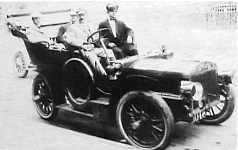
The new, 4-cylinder Model D
touring car
Bare chassis/bodies:
In 1905, various bare chassis with hood could be bought as follows: Model F $800,
Model E $700, Model B $750. Bodies without hood could be bought too: Model
F $150, Model E Runabout $60, Model B with rear deck $60 ($10
reduction without rear deck); tonneau or surrey seating for Model B cost $100
each; wheels with tires cost $250 for Model F (30x3½" 76.2x8.89cms), $210
for Model B (30x3" 76.2x7.62cms) and $200 for Model E (28x3"
71.12x7.62cms).
Trivia
(1): The First Cadillac to
be used by the U.S. Military was a Model F with back-to-back seating and an open
cargo body. It was purchased by the Signals Department
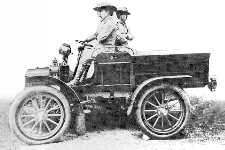
Trivia
(2): In The Automobile,
for June 7, 1906 [excerpt supplied kindly by author and friend Michael Bromley] there is a
snippet entitled [Cadillac?] Creates Thrills on the Coast. It reads: A
thirty-foot leap with an automobile across a gap at the foot of a steep incline is a
performance with which Doctor Carver has recently been thrilling spectators at
Agricultural Park, Los Angeles, Cal. After making a score of such sensational leaps in
that city he planned a tour of California with his new "stunt". The accompanying
reproduction [?] from a photograph shows the "Doctor" in the midst
[middle?] of one of his wild flights. As shown, the essential equipment is a wooden
incline ending at the bottom near the ground in an abrupt upward curve, forming the
segment of a circle. Thirty feet distant is a sort of landing platform upon which the car
alights after its leap. There is nothing but the driver's steady nerve and hand to hold
the car to its course. The machine used for this feat is a second-hand Cadillac runabout
of 1905 model [sic] bought from the Lee Automobile Company [later Don Lee] of
Los Angeles after it had seen six months' hard usage on the road. The leap is a very
severe test of the springs, axles, and, in fact, all parts of the car, as may easily be
imagined [I'll bet!]. The boys at Cadillac got a hold of that snippet and used
it as the theme of one of their advertisements for the 1906 models; in fact, the photo was
carefully doctored to show a 1906 Model K runabout in lieu of the original Model E used
for the stunt. The ad said, inter alia: While this [performance] proves
nothing to the person who wants an automobile to meet ordinary conditions of road travel,
it does show that the strength of the Cadillac is never found wanting, no matter what the
test.
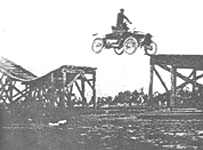 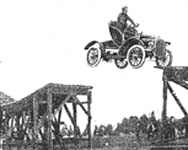
Left: the "reproduction" photo from The
Automobile showing a 1905 Model E
Right: the "doctored" picture used in the Cadillac advertisement made to look
like a 1906 Model K
1906
Facts: Cadillac
claimed to be the largest manufacturer of automobiles in the world and when plant
alterations were completed would nearly double its capacity from 30 to 50 machines a day,
including an expected 400 4-cylinder cars per year, in order to keep up with demand
(article in AU, 22.3.06); 1200 workers were on the force and Cadillac expected to
take on another 1000. New fire precautions were taken following the disastrous fire of
April 13, 1904. The first Cadillac script began to appear on radiators, all
1-cylinder had 76" wheel base (193,04cms), 10HP motor, prices $750-950, first closed
bodies appeared (bought from Seavers & Erdman, Detroit); the first closed
body was ordered by Leland and nicknamed Osceola after Seminole Indian chief. Facts
excerpted from 1906 catalog: all 1-cylinder Cadillacs feature copper water jacket,
mechanical operated vertical valves, variable inlet control, 2-speed planetary gears
(3-speed on 4-cylinder models), mechanical forced-feed lubrication, interchangeable
adjustable motor bearings, safety starting device, pressed steel channel frames, jump
spark ignition, spark coil on dash, Brown-Lipe spur differential, balanced
double-acting clutch bands, 2 double-acting brakes (external contracting and internal
expanding), steel hubs, 3-spring suspension with rocker joint on front spring, adjustable
ball-jointed radius rods, ratchet foot-pedal brake action, automatic elastic-stop
diaphragm carburetor, rack & pinion steering gear, 7-gallons fuel, 3-gallons coolant,
foot-actuated low-speed control, high gear and reverse on hand lever, concave steel
dashes. All 4-cylinder models have shaft and bevel-gear drive with special planetary
transmission giving three speeds forward. These cars had non-adjustable Hess-Bright
ball bearings throughout. Model M bare chassis and hood, including 30x3½"
(76.2x8.89cms) tires $800; Model K body without hood or dash $75; similar Model
M body $175. Article in AU, 01.04.1906, pp.19-20.
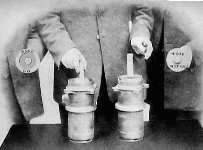
Precision gauges used to measure
cylinder bore to 1/1000th of an inch
Easy ID: Model K,
2-seater runabout and Model M, 4-seater Touring car both feature gracefully
curved tulip body [seat sides]; curved rear fenders, lower edge level with upper part of
wheel hub; Models H & L: rear fenders flatten out; 4-seater touring cars have
very ornate, curved rear door; Model H coupe and Model L limousine have
almost square window glass in side doors. All models have rounded side lights in
horizontal, tubular casing.
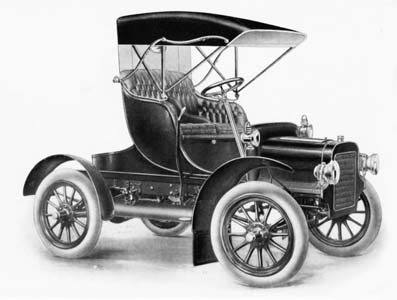
From factory brochure
[ ZTV collection ]
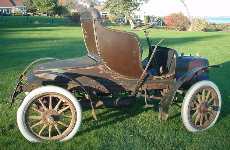 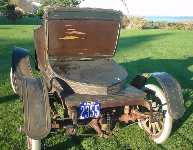
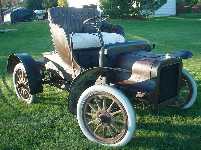 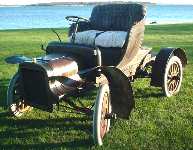
This all original Model K tulip-bodied
runabout is owned (2003) by Dick Shappy of RI;
its original Purple Lake color appears to have faded and has turned to fudge
brown
[ Photos: © 2003 and courtesy of Mr. Shappy ]
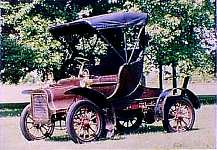 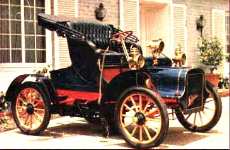
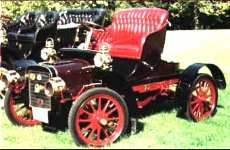 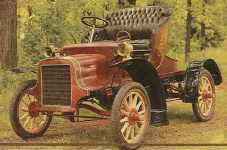
More Model K runabout survivors
In a museum in western Australia there is a surviving Model M
with chassis #662 and engine #9400. It is the winner of three awards at the WA Tourism Awards
2006: Winner - Motor Industry Centenary Awards 2003, Finalist - Fremantle First
Business Awards 2003. This info from Graeme Cocks, Chief Executive Officer, "Speed,
Style and the Automobile"
Fremantle Motor Museum
PO Box 1520
Fremantle
WA 6959
Ph 9336 5222 - Fax 9336 5522
Email gcocks@fremantlemotormuseum.net
Web site: www.fremantlemotormuseum.net
[ no photo currently available ]
Models: Ten models in
company catalogs; five 1-cylinder
models and five 4-cylinder cars. Single-cylinder models: (1) Model K light runabout
(Victoria), 2-pass., $750, 1100 lbs ($780 with rubber buggy top, sides and storm
apron, $800 with leather top, sides and storm apron - lamps not included), not convertible
to 4-seater; tulip seat sides (also known as the "turtle back" design), front
divided seats trimmed in hand-buffed leather, standard color for upper body, seat panels
and doors was purple lake1
(a deep wine color), with light carmine striping, lower body was black; frame, axles and
wheels were dark carmine with light carmine and black striping; tools in sloping rear
deck, 74" wheel base (193,04cm), tread 56" (142.24cms) (optional 61")
(154.94cms.), wheels 28" (71.12cms.), Dunlop tires 28x3" (71.12x7.62cms), gear
10-38 (optional 10-41 or 10-34, weight approximately 1100 lbs., over-all length 9'2"
(279.4cms.), over-all width 5'8" (172.72cms.), over-all height 4'6" (137.16cms),
10HP; such a model appeared in a popular advertisement of the early part of century called
Leaping the gap; photo (CLCA 1984, p.31; CLCA 1990, p.29). (2)
Model M,
light Touring car (Victoria), with tulip body, for 4 passengers,
$950 (without lamps), not convertible to Runabout for two passengers; tread 56"
(142.24cms) (optional 61" 154.94cms), wheels 30" (76.2cms.), wheel base 76"
(193,04cm), Dunlop tires 30x3½" (76.2x8.89cms), color same as Model K, two
18" (45.72cms) wide side doors, divided front seat, gear 10-41 (optional 10-38 or
10-45), weight approximately 1350 lbs., over-all length 9'7" (292.1cms.), over-all
width 5'8" (172.72cms), over-all height 5'6" (167.64cms), 10HP, same 5x5"
(127x127mm) 1-cylinder motor in use since 1902 (chain drive), color as for Model K;
black upholstery and trimmings in buff or red buttoned pattern; cape cart top available
for $75 extra - secured to front frame by 2 leather straps); this car is regarded as a
classic in styling as it features traditional and graceful curves that are usually found
in a Victoria coach; the forward sweep of both front and rear body formed an
elegant pattern; it was widely copied and came to be known as a tulip or turtle back body.
(3) Model M, delivery van (for those who would not entertain the idea of
having to revert to a horse-drawn vehicle!) $950, approx. 1400 lbs; tread 56"
(142.24cms), wheels 30" (76.2cms), wheel base 76" (193,04cms), Dunlop tires
30x3½" (76.2x8.89cms), standard color was purple lake, gear 9-45, enclosed
van body is not detachable; double doors at rear; inside dimensions: over-all length
42" (106.68cms), over-all width 40" (101.6cms), over-all height 50"
(127cms), capacity 500-600 lbs, 10HP, same 5x5" (127x127mm) 1-cylinder motor. Also
available with single-cylinder motor were: (4) the Model M, 2-4 seater car
with a folding tonneau and (5) the Model M coupe. In the 4-cylinder line
on 98" wheel base 30 H.P. were (6) the Model H, 2-passenger runabout,
4-cylinder, 30HP, $2400 without lamps ($2500 with top), lamps optional, (7) the Model
H, 5-passenger side-entrance Touring car, 4-cylinder, 30HP, $2500, 2,400 lbs ($2625
with top), lamps optional, (8) the Model H, 2-passenger Coupe, 4-cylinder,
30HP, $3000, 2500 lbs, beveled window glass, rear window drapes, lamps optional. On the
110" wheel base (279,4cms), 40 H.P. were (9) the Model L, 5-passenger
or 7-passenger Touring car, 4-cylinder, 40HP, $3750 ($3900 with top), 7-passenger car had
rear-facing auxiliary seats, lamps optional, weight 3,000 lbs [the late Phil Dumka said
2850 lbs] and (10) the Model L, open-front Limousine, 4-cylinder, 40HP,
$5000, 3600 lbs, an opulent car, 5 passengers inside plus 2 outside; satin ceiling,
Morocco leather upholstery, lamps standard, bell, speaking tube, lowerable French
plate-glass windows. Article in AU for 05.24.1906 tells the story of an
up-to-date car. Article in SCC tells of restoration of Model M
tulip tourer.
Trivia
(1): Twelve Cadillacs were
used by the army for relief operations following the San Francisco earthquake that year.
Initially, I thought they might have been simply requisitioned by the army. In fact,
author and friend Michael Bromley sent me a snippet from The Automobile for June
7, 1906, reading as follows: GENERAL FUNSTON'S AUTO RELIEF CORPS - Immediately
following the earthquake at San Francisco, General Funston, who was in command of the
United States military forces quartered there, assumed charge and purchased for relief
work twelve Cadillacs [my emphasis], nine of which are
shown in the photograph [below]. The picture was taken at Fort Mason,
General Funston's headquarters, after the stress of the relief work was over, and is
interesting in view of the great work performed by automobiles in saving lives and
personal property from the flames which followed the seismic shocks.
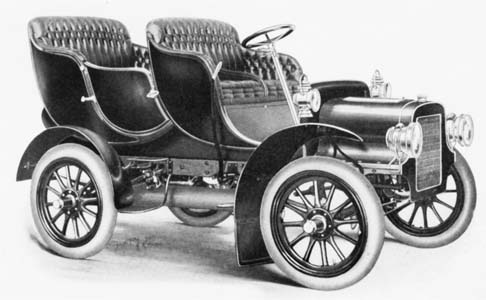
From factory brochure
[ ZTV collection ]
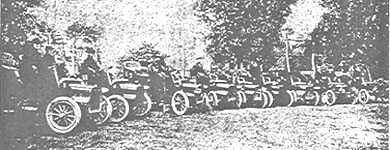
Nine of the twelve Cadillacs the army bought for
relief work in SF
Trivia
(2): The enterprising
agents of the Cadillac Motor Car Company at Richford, VT, Manual Bros., conceived the idea
of mounting a horse on a chassis, and entering the float thus arranged in a recent
[Fall 1906!] parade in that city. The little car handled its load of 800 ponds of
horseflesh with apparent ease and the horse seemed to enjoy the novelty of the thing as
much as the assembled citizens who witnessed the parade. Manuel Bros. state that the
exhibit proved an excellent advertisement for the automobile [excerpt from The
Automobile, September 13, 1906, provided kindly by Michael Bromley].
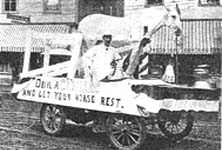
Banner reads: Drive a
Cadillac and let your horse rest !
Trivia
(3): [This text is the
caption of a magazine photo published in 1924] Seeing is believing, so for the benefit
of skeptics we produce a picture of a 1902 single-cylinder Cadillac which is still giving
excellent service. An electrical company at Fitchburg, Massachusetts, submitted this
piocture of the venerable old Cadillac "one lunger". This is a convincing proof
of the durability of Cadillac cars -- twenty-six years of continuous service and still
functioning perfectly.
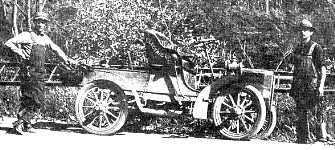
_______________________________________________
1 Auto buff, Harry W. Allen contacted me in September
2004 and told me the story of this color: My great-great-grandfather's last name was
Hurley; he was a head of Fisher's paint and bodywork department (perhaps a
supervisor or manager) at the time it was taken over by General Motors. He had the Hurley's
Purple Lake named after him; it was a very deep plum color.
Related
Trivia: Mr. Hurley is
believed to also have overseen the bodywork done on a Cadillac purchased by Henry Ford as
a gift for his son. A Ford was not good enough for a Ford, and so Henry decided on a
Cadillac instead. The work on this car was very kept much under wraps, to avoid the
obvious bad publicity. Mr. Hurley (and everyone else who worked on the car) was paid a
very nice sum by Mr. Ford, personally, for his efforts and for his discretion.
Anyway, that's all I know about the gentleman. My reason for trying to locate him now is
that I am in the process of rebuilding a car (a '69 Pontiac GTO), and would repaint the
car in Hurley's Purple Lake, if I could get a chip or number for it. Obviously, any
additional information on my relative would be greatly appreciated, as well.
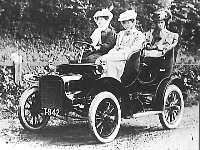 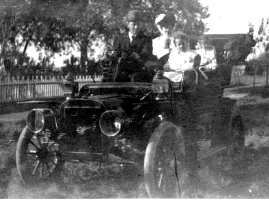
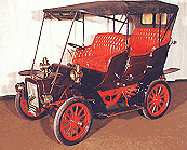
Model M touring Victoria, with
so-called "tulip" body
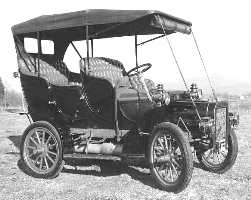
 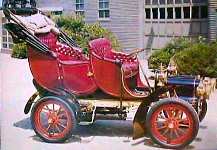
Model M, touring Victoria,
survivors
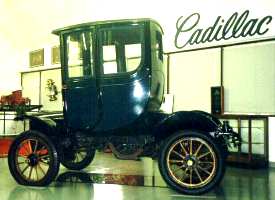 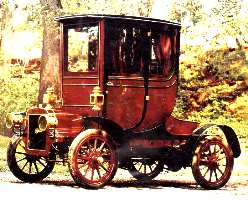
The first fully enclosed Cadillac was built in 1906,
on a 1905 chassis
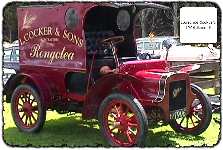
Model M delivery van
New, it cost $950
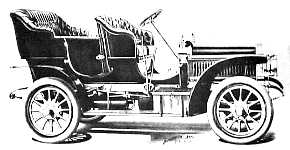
The 4-cylinder Model H touring car differed
from
the Model L in having a higher rear door
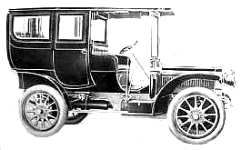
Model L limousine cost a phenomenal $5000 in
1906;
in today's dollars, that translates to around $95,000
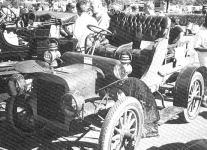 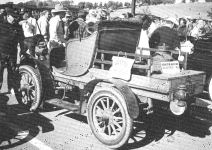
Delivery pickup conversion of 1906 runabout
1907
Facts: sales volume
down 37%. Leland imported a set of Swedish Johansson gauge blocks (Jo-blocks) on
the GO / NOT GO principle to facilitate the manufacture of precision parts; tires
(all) 30x3" (76.2x7.62cms) Dunlop or Clincher tires. Transmission: selective sliding
gear in aluminum housing. Model G was announced in December, 1906 to complement Model
H line; it was designed to meet the needs of those who wanted a medium weight touring
car with plenty of power, the same facilities as found in larger cars but at a lower
purchase cost and moderate upkeep (these cars were first rated at 20HP then upgraded to
25HP). In a sales brochure for the 1907 models Cadillac asserts that its factory is the largest
of its kind in the world. Its facilities and equipment are unequalled. The enormous
plant is the most modern in existence and is replete with the latest most improved and
best machinery possible to obtain. Already in 1907 Cadillac defines automobile
manufacturing requisites (and claims to meet them) as (1) general efficiency, (2)
accessibility, (3) simplicity, (4) durability, (5) interchangeability, (6) economy and (7)
"value received". Standard tires: Hartford or Morgan & Wright Dunlop type; G
& J Clincher tires available at no extra charge. Cadillac still recommended crating of
cars to be shipped over long distances. This service cost $10 net for single-cylinder
models and $20 for 4-cylinder cars.
Easy ID: All models
have squarish side lights in a cubic casing; headlights are rounded, in a trumpet-shaped
casing. Like 1906 Models; new Model M, 4-seater touring car with
straight-line molding through center of body and flat rear fender; new Model M, 2
or 4 seater with folding rear tonneau seat (body below front seat bulges outwards); Model
M coupe and Model H limousine have oblong window glass in side doors;
4-seater touring cars have less ornate rear door; Model G has straight-line
molding through rear body, including door; Model H does not have the molding
through the door; Model G runabout has curved rear fender (front and rear fenders
are joined by running board - this model available with single or double rumble seat).
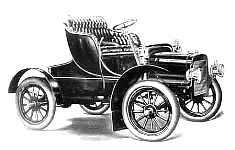 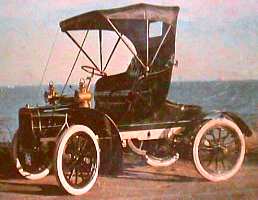
1907 Model K runabout (right, a survivor)
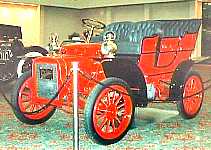 .jpg)
Model M light touring car
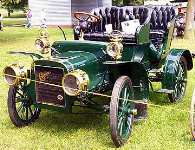
Model M light touring car, with folding
tonneau
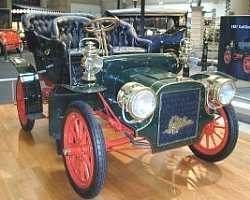 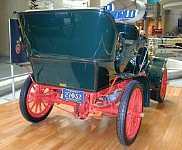
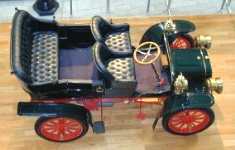 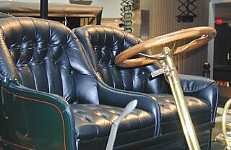
Beautifully restored Model M from the
Cadillac Historical Collection
[ Photos taken during the 100th Anniversary CLC Grand National in Saratoga, NY ]
Models: (1) Model
K, 2-passenger runabout, $800 ($750 for stripped model), 1100 lbs, $75 for body only,
lamps optional, three optional tops, full leather Victoria top $100, full rubber Victoria
top $40, leather buggy top $70; small photo, (C&D card set [2], one shown
erroneously as 1905 Model C) (CLCA 1987, p.24; [see Leland
Award]), (CA 2/91, p. ???), (SS 9/89, p.3 [identified as 1908
model?]). (2) Model K with Victoria top, $925, (3) Model
M: Victoria light Touring car, $950, cape cart-top $100, standard color as
in 1906 purple lake; nice photos in pre-war monographs, front, rear and
instrument panel. (4) Model M, straight-line light Touring car, $950, 1350
lbs, top $100, standard color Brewster green with red hairline stripe and red running gear
with black striping. (5) Model M, light Touring car, with folding tonneau, $1000; photo (CLCA
1978, p.30 [???]). (6) Model M, Coupe, $1200 [the late Phil Dumka said $1350],
30x3.5" (76.2x8.89cms) tires, (7) Model M, light delivery wagon,
$950. (8) Model G, 4-cylinder, 2-seater runabout, $2000, 100" wheel
base (254cms), 20HP, optional lamps; (9) Model G, 4-cylinder, 3-passenger
roadster with dickey seat [rumble seat], 3-bow buggy top, $2000, 100"
wheel base (254cms), 20HP, optional lamps, selective sliding gear in aluminum housing,
available with Victoria top, standard color Brewster green with light green
running gear and white hairline stripe. (10) Model G, 5-passenger Touring car, with
or without top, $2000, direct shaft drive (no chains), selective sliding gear changer,
20HP, 100 wheel base (254 cms), cape cart-top $120, rear side doors, lamps optional. Model
G chassis, painted and striped, available for $1900. (11) Model H:
Touring car, 4-cylinder, 30HP, 102" wheel base (259,08cms), $2500. (12) Model
H, 2-passenger runabout, $2400, (13) Model H, 2-door, 2-passenger
coupe, $3000, (14) Model H, limousine, 30HP at $3600, the result of Henry
Leland's pursuit of and passion for precision (catalog boasts this model as being for
the motorist whose ideals are realized only in a car which affords the highest degree of
comfort and luxury with ample power for all reasonable requirements) 102" wheel
base (259,08cms), 4-leaf springs of the finest steel, best hickory artillery wheels,
34x4½" (86.36x11.43cms) tires on Midgley Universal rims, $3600, 43/8x5" bore
and stroke (111,13x127mm), like Model D; rear compartment luxuriously upholstered
in rich black leather over deep-coiled springs and genuine curled hair; a speaking tube
provided communication with the driver, whose compartment was only partly enclosed (top
and windshield); elegant side lanterns were of cut glass; ride was epitome of ease and
comfort. Incomplete cars were offered in the condensed catalog for 1907, as follows: Model
M chassis with dash, hood, wheels, tires ($800), similar incomplete Model K
($750). Separate bodies were priced as follows: Model K body ($75), Model M,
in both Victoria or straight-line style ($175).
Trivia (1): Three 1907 Cadillacs participated in a standardization
test in 1908, winning for Cadillac the coveted Dewar Trophy. On the great
concrete oval of the Brooklands Motordrome near London, said Maurice Hendry of
New Zealand, they looked like flies crawling around a dinner plate.
Trivia (2): AU reported 02.211907, p.305, that a Mr. F.G.
Plummer of Seattle, WA, set a new record by driving a single-cylinder Cadillac non-stop
for 1000 miles (previous record had been 600 miles); it took 71 hours and 32 minutes to
achieve this feat in the early part of the year, driving through rain, sleet and snow.
1907-08
Special Model G taxi
available on request [source ???]
1908
Facts: First fully
enclosed production Cadillac, the Model T coupe; front and rear windows could be
lowered; side windows could be removed; closed body was removable and could be replaced
with an open 2-seater or 4-seater body; (SS 30th anniversary issue, p.38);
1-cylinder motor consisted of 2163 different component parts; Cadillac began tooling up
for new, 4-cylinder Model 30, all 1-cylinder 1908 models on 76" (193,04cms)
others 82" wheel base (208,28cms), Cadillac now made its own tops; this is the year
that three of the 1907 Model K cars in the showroom of Cadillac's UK agent
(Frederick Bennett) were entered in a competition that earned Cadillac the Dewar
Trophy (effectively awarded in 1909). Each of the 1907 runabout models that were
broken down, scrambled and re-assembled consisted of 721 component parts.
The RAC's Dewar Trophy
Easy ID: Front and
rear fenders joined by running boards (except Model T coupe and Model M
delivery van); new headlights (still extra-cost equipment on all models) feature large,
rounded, tubular casing with upper, 5-holed ventilating cap and convex rear end cap (the Model
M delivery van, Model H touring car and limousine, and Model G
roadster are featured in the product catalog with the old style lamps). Model T
touring car is like 1907 Model M straight-line model, except no molding through
rear door; Model T Victoria is like 1907 Model M Victoria but has
running boards and flat rear fenders. Model S runabout is available with tulip
body and single rumble seat or standard body and double rumble seat with folding
lazy-back; Model T coupe and Model G limousine have squarer, oblong
window glass in side doors; Model H limousine is basically unchanged. Model H
touring car now has straight-line molding through rear body, including door. Model G
has Cadillac embossed on radiator shell.
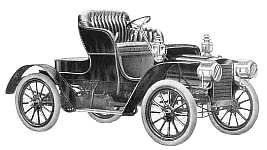
(Above and below): 1908 Model S runabout
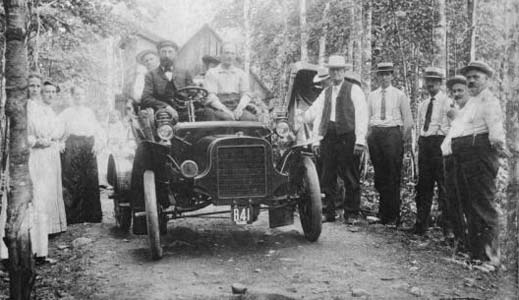
Here's on old photo of a (then new?)
Model T touring car
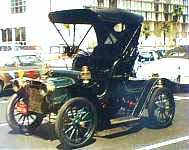 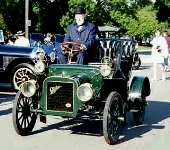 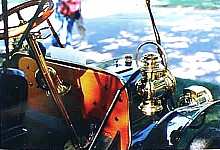
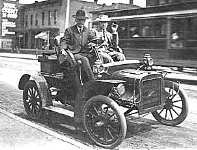 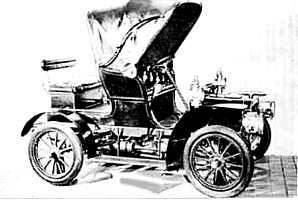
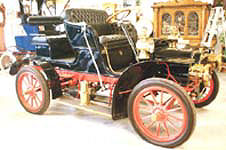
Model S, 2-pass with rumble seat
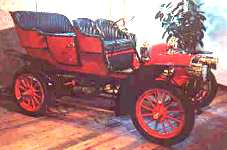
Model T touring car
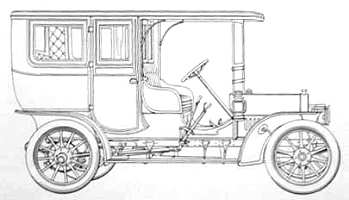 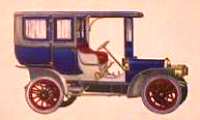
Model G, 4-cylinder limousine
Models: Featured in
1908 sales catalog; also CATJ, 3/08, p.74. (1) Model S:
straight-line runabout, 10HP, $850 - incomplete car (chassis, wheels, dash and hood) cost
$800, body in standard finish, including upholstery and spring seat cushions cost $95;
standard color: dark blue body and side rails with light blue running gear, blue pin
striping, optional lamps; good photo in CLCA 1973, p.22; small photo in CLCA
1981, p.27; the late Phil Dumka lists also (1b) same car with two-seater rumble
seat for $885; (2) Model S: runabout, 10HP with Victoria body,
$850. Phil Dumka lists also (2b) same car with two-seater rumble, $875; (3) Model
T, 4-passenger straight-line touring car, $1000 - incomplete car (chassis, wheels,
dash and hood) cost $850, body in standard finish, including upholstery and spring seat
cushions cost $175, tires 30x3½ (76.2x8.89cms); photo in CLCA 1976, p.29; story
and photos in CLCA 30th anniversary issue, pp.6-8). (4) Model T,
coupe, $1350, dark blue and black with blue running gear, body removable in summer to
convert to runabout. (5) Model T touring Victoria, $1000 -
incomplete car (chassis, wheels, dash and hood) cost $850, body in standard finish,
including upholstery and spring seat cushions cost $175 - without lamps or top, standard
color: Brewster green with light red striping and red running gear with dark green stripe.
(6) Model M delivery van on 76" wheel base, $1000 [Phil Dumka lists
it at $950], Brewster green with red running gear. (7) Model G roadster
with single dickey (rumble) seat, $2000, optional lights and top, standard color:
French gray with fine red striping, red leather upholstery, 20HP, 100 wheel base (2m54)
like 1907 [Phil Dumka lists also (7b) a roadster with double dickey (rumble) seat,
$2025. (8) Model G touring car, $2000, optional lights and top, dark blue
body and frame rails, fine primrose stripe, cream and yellow wheels and axles with dark
blue stripes; optional color: Brewster green with red running; 20HP, 100 wheel base
(254cms) like 1907. (9) Model G Limousine, $3000, electric dome light,
speaking tube, dark blue and black with dark blue running gear and light blue striping,
102" wheel base (259,08cm), $3600, 43/8x5" bore and stroke (111,13x127mm) like
Model D. (10) Model H touring car, $2500, Brewster green including running
gear, optional red running gear with dark green striping. (11) Model H
limousine, $3600, 30HP, 50mph (80kmh). Phil Dumka lists also (12) a Model H
roadster [???], $2400. Cadillac made its own tops whose quality was in keeping with
quality of the cars themselves. Bows were No. 1 ash with double steel tube bow sockets and
substantially reinforced rear sockets.
Trivia (1): [see 1907, above] Three 1907 Cadillacs
participated in a standardization test in 1908, winning for Cadillac the coveted Dewar
Trophy.
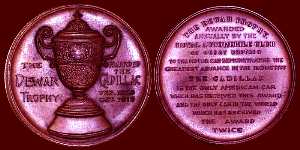
Commemorative medallion celebrating
Cadillac's winning the Dewar Trophy twice
Trivia (2): In 1908, a brand new Cadillac "30", straight
off the assembly line, covered more than 1,000 miles on country roads in Michigan, Ohio
and Kentucky, without ever stopping or missing a beat. The engine was started in Detroit
on October 17 and stopped on October 19, 1908. This may not seem much of a feat, 100 years
later, but in those early days of motoring it was quite exceptional.
[ images]
1909
Facts: Cadillac is
incorporated in General Motors (GM). Good write-up in CATJ, 12/08,
pp.110-116. Models illustrated in CATJ, 3/09. p.104; Introduction of new, Cadillac Thirty;
named after its horsepower capability. Cylinders gauged by Johannson Go / Not Go
gauges and again ground to within 1,000th of an inch; ash body frames, aluminized sheet
steel doors; sheet metal fenders were finished in several coats of black enamel, standard
body finish Royal blue (body, hood, frame, axles and wheels) with light blue striping;
black radiator; mahogany dash with brass edging, mahogany finish door trim and hood sills,
seats upholstered in black leather tufted over deep coil springs and fine quality genuine
curled hair; hickory artillery wheels with steel hubs, standard tires: Hartford
32x3½" (81.28cms) optional 33x4" (83.82x10.16 cms). Prices down from a high of
$3600 for some limousine models to only $1400 for all 4-cylinder cars. Specifications:
4-cylinder motor, 4x4½" (101.6x114.3mm) bore and stroke, 5-bearing crankshaft,
storage battery and dry cells for jump spark ignition, leather-faced cone clutch, sliding
gear transmission, 3 forward, 1 reverse, special alloy steel live rear axle, tubular front
axle, 1 internal and 1 external brake direct on wheels, worm and sector steering,
106" wheel base. (269.24cms), tread 56" (142.24cms) (optional 61")
(154.94cms), front semi-elliptical springs, rear ¾ platform; muffler could direct exhaust
gas to operate a horn or even a foot-warmer, 16" diameter steering wheel (40.64cms),
speed (gear) changes by hand lever operating in "H" plate, foot throttle, top
speed circa 50mph (80kph), 13-gallons fuel, 6 pints oil, side oil lamps + tail lamp
included, horn and set of tools including pump and repair kit for tires. Optionally:
32x4" (81.28x101.6cms) tires ($45), Bosch high tension magneto ($117), Dow high
tension type ($100), Eisenmann low tension type ($126), Splitdorf low
tension type ($100), two storage batteries instead of one ($18), one 40A + one 60A instead
of one 40A ($25), two 60A instead of one 40A ($32), Rushmore lamps ($23), Rushmore
generator ($12), Prest-o-Lite gas tank for lamps ($25), gas-lamp brackets ($3.60
pr.) labor for fitting gas lamps ($8), Metzger folding windshield ($50), Gabriel
horns (from $15-35), Stewart & Clark speedometers (from $15-40), color
options: red with black molding ($40), French gray [no guarantee!] ($50). Bare chassis
including hood, dash and fenders [no lamps] cost $1350; touring car body cost $250,
detachable tonneau for demi-tonneau cost $115, and rumble seat with toolbox [base
only] was $50. Tops: rubber cape cart for touring car or demi-tonneau cost $75,
same but black mohair was $125, rubber top for roadster cost $55, full leather top was
$110 and special black mohair, $100; slip covers for seats were $75 (touring car & demi-tonneau)
or $45 (roadster); dust hood [top boot] for laid back tops cost $12.
Easy ID: Much longer
bodies and hoods [all models]; touring car has flat rear fender and taller body than demi-tonneau
and roadster; the latter two models have curved cowling between driving area and hood.
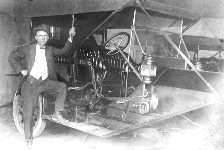 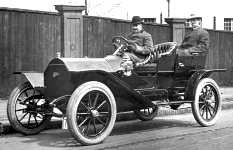
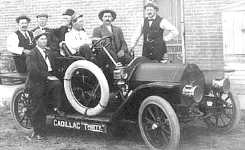 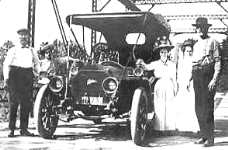
Above two rows: period photos
of the 1909 models
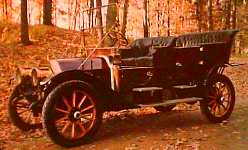 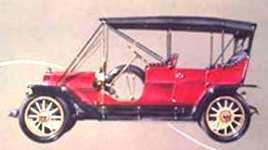
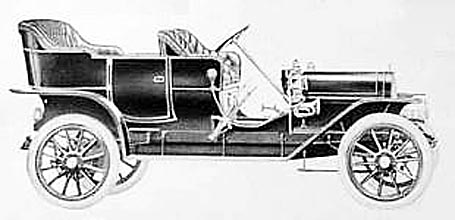
1909 Model G touring car
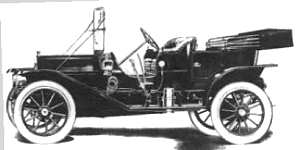 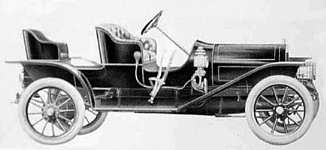
Left: Model G demi-tonneau. Right: Model
G roadster
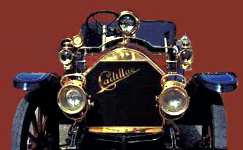
Front grille: detail
Models: 1908 models
still advertised in CATJ, 3/09, p.104. (1) Model T touring car
($950). (2) Model S runabout ($800), same car with artillery seat
for 2 extra passengers ($850). (3) Model T coupe ($1300). All 4-cylinder
models priced at $1400. (4) Model 30 2-door, 5-passenger touring car,
$1400 (Danbury Mint scale-model tourer, CC&CC 6/1981, p.14, 16-17). (5)
Model 30, 2-door, 4-passenger demi-tonneau, $1400, could seat two
passenger in rear tonneau which was removable, leaving a plain deck which could
accommodate a rumble seat. (6) Model 30, 3-passenger roadster with
detachable rumble seat, $1400; photo/ill: (CLCA 1978, p.35).
Trivia: An early advertisement this year explained how Cadillac
would manufacture 10,000 4-cylinder models in 1909 when, five years earlier (in 1904), all
auto factories in America combined were able to build just 44 such cars in one annual
season. In fact production failed to reach 2000, but nonetheless a new manufacturing pace
was set. 1909 production was six times that of 1908.
1910
Facts: Fleetwood
Body Corporation, founded [information drawn from 1929 Cadillac catalog]; adoption of
Delco electric system (Dayton Engineering Laboratories Co., Dayton,
Ohio) comprising only coil box, controlling relay and switch; this was a major improvement
in reliability over the former magneto ignition. Specifications: general body
specifications like 1909 models; motor up to 33HP, 4¼x4½" bore and stroke
(107.95x114.3mm) (bore up by ¼" 6.35mm), new Delco ignition system, chrome
nickel steel gears, transmission shaft and clutch shaft, gear ratio 3½ to 1 (optional 4
to 1 on touring car and demi-tonneau, 3 to 1 or 4 to 1 on roadster ), limousine 4
to 1, wheel base 110" (279.4cms) (except limousine: 120" - 304.8cms), tires
34x4" (86.36x10.16cms), (limousine 34x4½" 86.36x11.43cms), tread 56"
(142.24cms) (optional 61" 154.94cms), steering wheel diameter, up by 1"
(2.54cms) to 17" (43.18cms); options: tops from $60-95 (lowest price up $5), seat
slip covers from $40-60, Prest-o-Lite gas tank ($25), folding windshield ($30), Jones
speedometer (from $25-35), foot rail ($3.50), bare chassis on 34x4" (86.36x10.16cms)
tires ($1525), Thirty touring car body ($250), detachable demi-tonneau
($115), single rumble seat and tool box base ($50), plain deck replacing rumble seat or demi-tonneau
($30). Cadillac reproduced the contents of its 1910 product bulletin in a SEP
advertisement entitled The Story of the Cadillac.
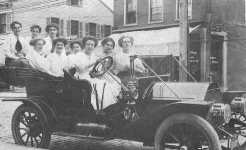
Outing of nine ladies in a spacious 1910 touring car
Easy ID: front fenders
are hooded; touring car has more rounded rear fender with flat extremities. New limousine
has flat rear fenders.
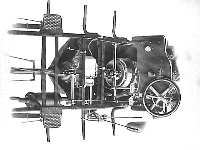 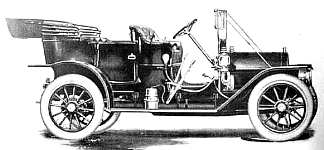
Left: Bird's eye view of bare engine. Right: Model
Thirty touring car
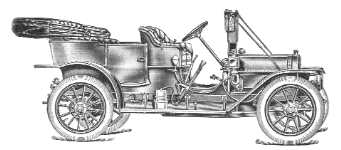
Another artist's view, from a period ad
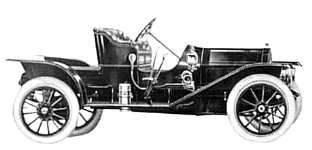 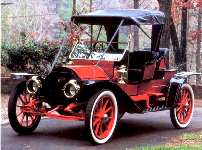
The Thirty roadster (a survivor, right)
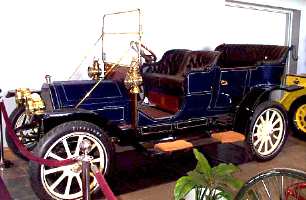 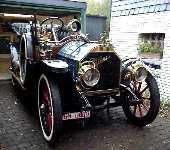
Two surviving Thirty touring cars
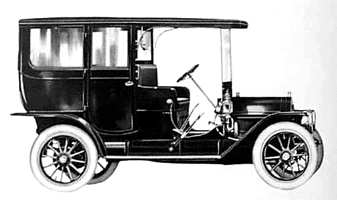
1910 Model Thirty limousine
Models: Like 1909, all
prices up $200 to $1600; Model 30 range included: (1) 2-door, 5-passenger
touring car, $1600; (2) 2-door, 4-passenger demi-tonneau, $1600, (3)
2-passenger roadster, $1600, (4) 2-door, 3-passenger coupe, $2200, (5)
2-door, 7-passenger limousine, $3000, with upholstery of genuine Morocco with
broadcloth trimming, mahogany ceiling over driver, 5-passenger seating in rear
compartment, electric dome light, toilet case, card case and speaking tube, large gas
headlights with Prest-o-Lite gas tank, windshield in Circassian walnut frame
could be swung up, under roof. Royal blue finish with black trimming; frame, wheels and
hood were striped; photo/illustration: good photo & story of demi-tonneau (CLCA
1987, p.2-11), touring car (CLCA 1977, p.3) >>>>> (???).
1911
Facts: Custom
coachcraft by Fleetwood begins. Specifications: general body specifications are
like 1910 models, bore and stroke 4½x4½" (114.3x114.3mm) (bore up by another
¼" - 6.35mm), 286.3 cu.in., 32.4 HP, special Schebler carburetor (air
adjusted from driver's seat), 14x2½" (35.56x6.35cms) brake drums, gear ratio touring
cars, demi-tonneau, torpedo and coupe 3.43-1 (optional 3.66-1), roadster
3.05-1 (optional 3.43-1), limousine 3.92-1 (optional 3.66-1), 116" wheel base
(294.64cms), 56" tread (142.24cms) (option 61" 154.94cms), wheel base up 6"
(15.24cms) to 116" (294.64cms), tires like 1910 34x4" (86.36x10.16cms),
limousine up from 34x4½" to 36x4½ (91.44x11.43cms), tread like 1910 56"
(142.24cms) (optional 61" 154.94cms), steering wheel diameter up by 1" (2.54cms)
to 18" (45.72cms); Royal Arch seat cushion springs designed not to strike
cushion base; linoleum covered running boards; standard wheel color: light cream with
black striping (optional : blue wheels), tire-holders; Prest-o-Lite gas cylinder
supplied on limousine instead of generator; standard equipment: pair of acetylene gas
lamps, tail lamp, horn, tools and tire repair kit. options: tops from $65-95 (lowest price
up $5), seat slip covers from $40-60, Prest-o-Lite gas tank ($25), automatic
folding windshield (up $10 to $40), bare chassis on 34x4" tires (86.36x10.16cms) up
$80 to $1525, Thirty touring car or demi-tonneau body (up $75 to $325),
detachable demi-tonneau (up $30 to $145), roadster body including rumble seat
($230), same without rumble seat ($180), single rumble seat and tool box base ($50),
4-door touring car body ($425), torpedo body ($475), limousine body ($1350),
coupe body with parts to interchange with demi-tonneau ($1000).
Easy ID: rear fenders
of all models except limousine are reverse-curved, instead of flat, at their extremities;
limousine retains flat extremities beyond the curved portion; base of rear doors on
touring car are curved instead of having the pointed coach curve; at the front
fenders are hooded; touring car has more rounded rear fender with flat extremities.
Limousine has flat rear fenders. New four-door touring car. New, torpedo model has inward
curving rear body and molding level with fold in hood.
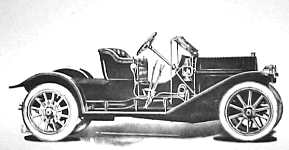
1911 Model Thirty roadster, with deck
Note upturned end of rear fenders
Models: Similar to
1910 cars but with cream wheels and black striping; black leather upholstery. Bare chassis
cost $1605 and complete bodies ranged from $145 to $475 ($1350 for the limousine).
Model 30 range includes (1) 2-passenger roadster [with deck], $1700. (2)
Same car with optional rumble seat, $1700. (3) 5-passenger standard touring car,
$1700. (3a) 5-passenger touring car with front and rear doors, known as
the Fore-door model, $1700 [the late Phil Dumka lists at $1800]. (4)
4-passenger demi-tonneau (the last year for this model), convertible to
2-passenger runabout, $1700. (5) 5-passenger torpedo, straight-line body with
center body molding running full length of car, $1850, an optional mohair top cost $95
extra, (6) closed coupe with functional rear deck, Prest-O-Lite tank
instead of standard acetylene generator, $2250. (7) 7-passenger limousine with
interior electric lights, speaking tube and Prest-O-Lite tank instead of
acetylene generator, $3000. Photo/illustrations: rear of touring car (CLCA 1976,
p.23); front view (CLCA 1976, p.26); articles: (CC&CC, 4/1975) {***}.
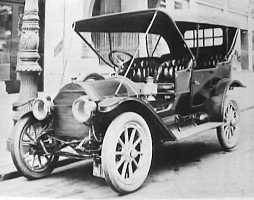 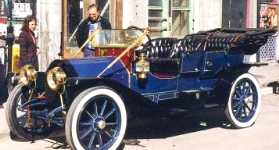
1911 Model Thirty touring car (a survivor,
right)
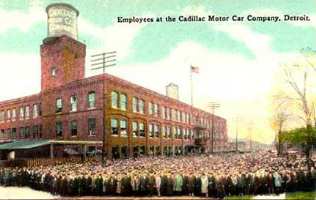
Cadillac employees gathered outside the plant in 1911
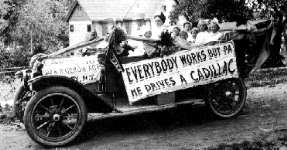
Coaching Day in Liberty, NY, August 23, 1911
Banner reads: Everybody works, but Pa; he drives a Cadillac
With six kids in the rear, plus a baby on Mom's knee...
...methinks Pa does more than just drive a Cadillac!
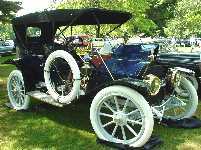 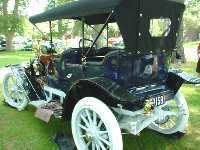
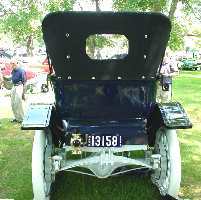 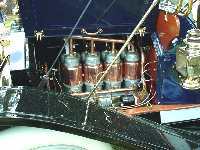
This perfectly restored demi-tonneau is in the
collection of Dick Shappy, RI
[ Photos: © 2003 and courtesy of the owner ]
Trivia: a trimmed
down 1911 roadster with no fenders was driven by a Mr. Beaudet into second place at the
Los Angeles race track. It came in first among the American-built cars that ran in
the race, covering 1,448 miles in 24 hours, being an average speed of 60.33 MPH, the best
performance ever done on a 30 HP automobile.
1912
Facts: The Cadillac
that has no crank, new electric lighting and electric starting and improved ignition,
credited to Cadillac engineer Charles F. Kettering [Boss Ket] but actually a
Cadillac-engineered feature adapted by Kettering, won Cadillac the Dewar Trophy
for 2nd time (awarded in 1913) after successfully starting and stopping the motor 1000
times; 1912 brochure mentions 50,000 Cadillac cars scattered all over the globe. Cadillac
company was prepared to replace any part of any car it ever built.; it described 1912 cars
as the most sturdy, the most dependable and the car of most enduring
service; in building the Cadillac limousine, instructions were to overlook nothing
the absence of which could cause the possessor to envy the owner of any other car, no
matter what its price nor the name it bore; start of production of 7th Cadillac body
style Phaeton (CLCA 1973, p.12); new body fabrication methods: Cadillac
bodies were now first modeled by hand in wax then a plaster cast was made from which dies
were then made for stamping different body parts from sheet steel. Bodies were mounted
over hard wood frames; specifications: bore and stroke unchanged (4½x4½")
(114.3x114.3mm), six-bearing cam shaft, ignition by dynamo furnishing current for
ignition, electric starting device and electric lights, Delco distributor system
with dry cell current, brake drums up from 14x2½" (35.56x6.35cms) to 17x2½"
(43.18x6.35cms), gear ratio touring cars, coupe and limousine 3.92-1 (optional 3.66-1),
phaeton and torpedo 3.66-1 (optional 3.43-1), roadster 3.43-1 (optional
3.05-1), 116" wheel base (294.64cms), 56" tread (142.24cms) (option 61"
154.94cms), wheel base 116" 294.64cms), tires 36x4" (91.44x10.16cms), steering
wheel diameter unchanged at 18" (45.72cms); gasoline capacity: 20-gallons (touring
car, torpedo and limousine), 14-gallons (phaeton, roadster and coupe),
linoleum-covered running boards with metal bindings, all bodies with 4 doors, aluminum
bodies on limousine and coupe (others steel), standard body color: Cadillac blue with
fine, light (blue?) striping (excellent torpedo battleship gray with fine black
striping, optional Cadillac blue), limousine and coupe had Cadillac blue lower panels and
doors with black upper panels and moldings, all wheels Cadillac blue; walnut dash and door
trimming, all other trimmings nickel-plated; dynamo with 80 a/h battery, Gray &
Davis electric lamps with adjustable focusing (special design for Cadillac finished
in black enamel with nickel trimmings - 2 headlamps with adjustable bulbs for high-low
beams, 2 side (cowl) lamps, 1 tail lamp) and a speedometer light; Hans gasoline gauge on
dash, horn, foot-rail in tonneau, half rail in front, robe rail, tire-irons, tool box with
tools including pump and tire repair kit, cocoa mat in all tonneaus (except closed cars),
Standard speedometer with 4" face and lighting; options: top prices down, now ranging
from $60-90, seat slip cover prices also down, now ranging from $32-50, folding windshield
for touring car and phaeton ($40), for torpedo and roadster ($35), 36x4½"
(91.44x11.43cms) wheels and tires instead of 36x4" 91.44x10.16cms) ($50),
37x4½" (93.98x11.43cms) ($50), Cox front bumper of black enamel with nickel
ends ($18), Kamfee auto trunk ($30), trunk rack ($10), Baker demountable
rims with one extra rim ($25), Boston Model "C" clock ($15), Tuto
electric horn ($25), Kellogg 4-cylinder power tire inflator ($35), inspection
lamp with 8-ft cord ($2). Interchangeable body prices not listed, Hartford or Morgan &
Wright tires (36 x 4").
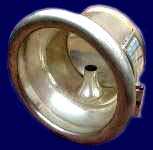
Electric starting and lighting
were the BIG news for 1912
Easy ID: All models
now have doors to the front compartment as well as the reverse-curve rear fenders; no
crank; electric starting and lighting. Coupe roof projects over hood; rear roof has upper
reverse curve. Limousine is fully enclosed car.
Models: "1912"
(slight price increase over last year) Models (1) 4-door 5-passenger touring car,
flat dash, (no more open door area in driver's compartment) ($1800), mohair cape top was
$90 extra, (2) new, 4-passenger phaeton, similar to 4-door touring car but shorter
body ($1800), (3) 4-passenger torpedo, recognizable by side molding
running entire length of body level with fold on engine hood, optional windshield and top
($1900), (4) roadster, fully enclosed, pressed steel cowl and side doors, 2-piece
folding windshield, luggage compartment in rear, folding top cost $60 extra, (5)
fully enclosed aluminum limousine with fixed partition, termed berline, no
more open chauffeur compartment, described as the Berline type with vestibule front
compartment; unbeveled, 3/16" thick crystal plate glass in windows and doors
(sliding open), plain (untufted) hand-buffed black leather in front, top cloth and floor
covering in gray linoleum with aluminum binding, American black walnut sashes, heel boards
dash, hood shelves and finish moldings, rear upholstered and trimmed in best imported blue
broadcloth, two folding seats, accommodation for 5-pass., best quality silk curtains on
rollers, two pillar lamps outside, two 3½" (8.89cms) dome lamps, sliding arm rests,
speaking tube, hat racks, toilet case, time-piece (clock), lever lock handles (Yale
locks), short robe rail with goat skin cover on inside of doors, 2 slip pockets on center
partition and 1 on each side, heavy nickel plating on exterior trimmings. Cadillac bodies
could interchange on same chassis so that a wealthy customer could buy a bare touring car
body and exchange it for the limousine body when desired ($3250). (6) coupe, less
angular lines), interior upholstered in best imported blue broadcloth with broad and
narrow lace trimmings, windows in door and rear quarters drop down; silk curtains, sashes,
windshield frames dash, etc. finished like the limousine in black American walnut;
removable rear-facing auxiliary seat increasing passenger capacity to 4 persons, folding
driver's seat allowing exit from both sides of car; coupe also had two side lamps; toilet
case contained time piece, mirror and two toilet bottles, ash tray and card case (all
silver mounted), Yale locks on doors, horn, hinged foot rail, sliding arm rests,
hat rack and pillar handles ($2250). Bodies of the coupe and limousine (the two enclosed
styles) were made of (much lighter) aluminum in lieu of steel. Photo/ill: chassis
propelled by self-starter CCI, 28:3, CLC 10/92 pp.4-5
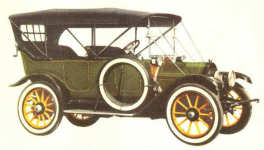 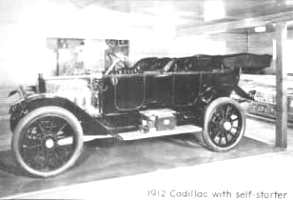
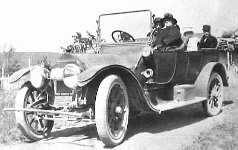 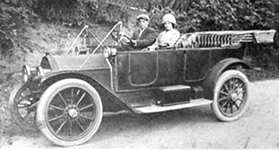
Above two rows: the new touring car
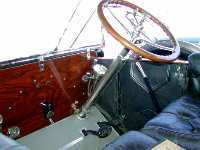 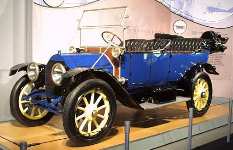 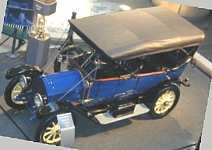
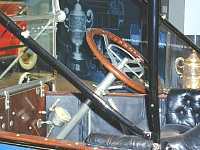 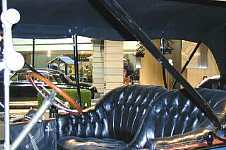
Above two rows: 1912 touring car from Cadillac's own
Historical collection
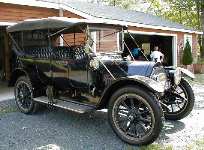 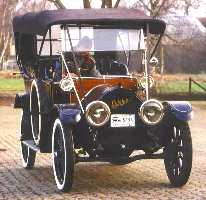
(Above two rows) Surviving touring cars from 1912
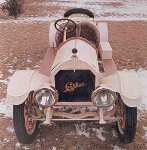 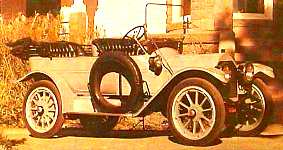
Two survivors. Left, the roadster, right the
phaeton
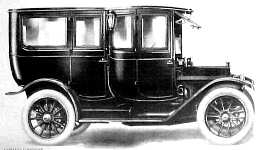
Model Thirty limousine
|